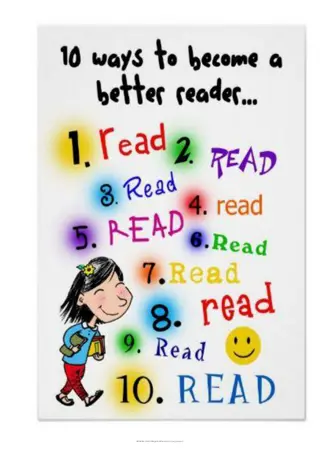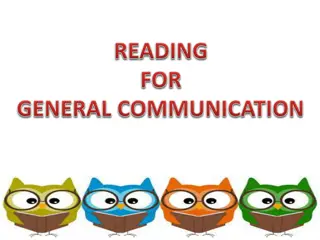Reading Assessment Guidelines for Students
Begin the reading assessment by starting with word lists below the student's grade level placement. Progress through word lists, evaluating accuracy and response time, to determine the student's reading level. Consideration should be given to decoding ability, recognition of patterns, and comprehension. Practice scoring word list responses and select leveled diagnostic reading passages based on the student's independent reading level.
Download Presentation

Please find below an Image/Link to download the presentation.
The content on the website is provided AS IS for your information and personal use only. It may not be sold, licensed, or shared on other websites without obtaining consent from the author.If you encounter any issues during the download, it is possible that the publisher has removed the file from their server.
You are allowed to download the files provided on this website for personal or commercial use, subject to the condition that they are used lawfully. All files are the property of their respective owners.
The content on the website is provided AS IS for your information and personal use only. It may not be sold, licensed, or shared on other websites without obtaining consent from the author.
E N D
Presentation Transcript
QRI-6 INTRODUCTION & PRACTICE
The Beginning Point It is recommended for this test that you begin with a word list that is two (or more) years below the student s grade level placement. For the purposes of our class, we will begin with a word list that is two years below the student s identified grade level. It is better to begin the student too low than to place him/her in a frustrating situation immediately. Little time will be lost if the list is too easy, and the initial experience of success may put the student more at ease. Grade Level Begin with the 1st 3rd Pre-primer or primer list 4th 5th 2ndor 3rdgrade list 6thgrade and above 4thand/or 5thgrade lists
Word Lists Scoring While administering the word lists, be sure to look for: Accuracy of word identification whether the student reads the word correctly or not Automaticity of response the response (correct or not) is given within one second One second can be identified using the phrase one thousand and one If the student scores 90% or higher (independent level) on the Total Number Correct, go on to the next word list. Continue this process until the student scores less than 50%. This means that s/he has reached frustration level. If the student scores less than 90% on the Total Number Correct for the first word list, go back to the previous word list and continue this process until the student reaches 90% (independent level).
Things to Consider: It is important to recognize that the graded word lists do not represent a true reading situation and therefore do not assess a student s comprehension ability. Rather, the lists provide an idea of how well the student can decode and/or recognize a word at various grade levels, which may help provide insight as to where the child s reading independent reading level is at. Additionally, as you observe the student completing the word lists, look for the following: How well does the child use letter-sound patterns? Is the child approaching each unfamiliar word as a new phenomenon? Or are they connecting patterns to any previously known words? What vowel patterns does the child recognize? Consonant patterns? Does the child recognize parts within multisyllabic words (i.e., syllables, initial/medial/final sounds)
LETS PRACTICE SCORING WORD LIST RESPONSES Wait for the following directions from your instructor.
Leveled Diagnostic Reading Passages Once you have identified the student s independent reading level (90% or above), you will select a corresponding leveled passage to begin assessing the student s reading abilities. NOTE: If you have additional data from your Cooperating Teacher s classroom that indicate a different reading level, you may use that data in consideration with the student s performance from the word lists. For students who are in grades below third grade, or who are demonstrating below grade level reading abilities, it is suggested that the student s read the passages aloud. For students in grades four and beyond, it is recommended that they read the passages silently. NOTE: If you are also looking for specific miscues to provide additional insight about the student s reading abilities, you will most likely want the child to read aloud.
Miscues As the student reads aloud, you will look for the following miscues (see below). A miscue is defined as any deviation from the printed text. As you record the miscues, here are some suggestions for how to code each miscue as it is presented. Types of Miscues Coding Suggestions Write what the student said over the word as it appears in print. Substitution Circle the omitted word. Omission Write in the insertion and mark it with a ^. Insertion If a student corrects a miscue, write the miscue and mark it with C. Self- correction If the student transposes two words or phrases, such as said John for John said, mark the reversal with a symbol. Reversal Mark miscuesthat change the meaning of the sentence as MC. Change in Meaning
LETS PRACTICE CODING MISCUES We will look at an example of how to read and score miscues on the following slide.
Lets imagine that a student was reading the following passage and provided the following errors. There are a total of 16 miscues identified in this passage (each one is numbered 1 16). Which miscues were substitutions? Which miscues were insertions? Which miscues were omissions? Which miscues were corrected? Which miscues changes the meaning of the text? NOTE: Some numbers may be used in multiple categories (i.e., 14 is both a substitution and was corrected)
Total Accuracy Additional Scoring Notes You can locate additional information about how to score miscues on pgs. 39 50 in the Administration and Scoring Guide: Word Identification in Context (Oral Reading), located in your QRI-6 Materials and Resources page. Independent Level: 98% Accuracy Instructional Level: 90% - 97% Accuracy Frustration Level: Less than 90% Accuracy Calculating Miscues When calculating the total accuracy miscue scores for students, you count up the total number of miscues identified on the previous slide. While students are reading aloud, they may still present the following miscues (see Figure 7.3); however, they will not be penalized with these type of miscues when determining their total accuracy score. For additional qualitative feedback, you may want to use the Miscue Analysis Worksheet.
Leveled Diagnostic Reading Passages Continued Prior to reading the passages aloud, you will ask the student to answer a series of Concept Questions. These concept questions will allow to see if the student s performance is based on his/her understanding of the reading passages or based on familiarity with the concepts presented within the text. After you ask the student the Concept Questions, write down his/her responses, and then calculate the student s responses. If the student scores 55% or more in how they respond to the questions, you have an idea that they have some familiarity with the story they are about to read.
Leveled Diagnostic Reading Passages: Retelling Once you have identified the student s independent reading level (90% or above), you will select a corresponding leveled passage to begin assessing the student s reading abilities. As the student is reading aloud, you will begin coding his/her miscues. Once the student has finished reading the text aloud, you will remove the passage and ask him/her to retell the passage as if they were telling it to someone who has never heard the story before. After the student has finished retelling the story, you can ask him/her if there is anything else s/he might like to add. If the student says no, you can restate the title of the passage to offer additional prompting, but you should not offer any further prompting after that. If the student still doesn t add any additional information, move on to the Comprehension Questions.
So, Whats the Purpose of Retelling? While retelling is not used to determine the student s independent, instructional, and/or frustration level in reading, it can provide insight for instructional purposes. If a student is unable to retell the contents of the passage, it may mean s/he needs additional instruction surrounding story structure (as in the case of a narrative retelling). Additionally, the Retelling section may be broken down into subcategories like main idea, key details, events, problem, resolution, etc. If a student is not able to recall any of these sections, it may mean s/he needs instruction within that concept.
Leveled Diagnostic Reading Passages: Comprehension Questions After the student has completed the retelling of the text, you will need to decide as to whether you will allow the student the opportunity to look back through the story as s/he answers the comprehension questions or if you will not permit Look Backs. Once you ve made that decision, you will begin asking the student comprehension questions about the text. There are two types of comprehension questions: Explicit questions that have answers which are stated directly in the text Implicit questions in which the reader must use clues from the passage to make inferences in order to answer correctly Answers are scored as either right or wrong with no half points awarded. While you, as the examiner, may prompt the student to provide clarification on an answer, you are not to provide additional hints or clues to assist the student in coming to the correct answer. After you have scored both the explicit and implicit question responses, you should begin to get an idea as to what type of comprehension instruction should take place next.
When to Discontinue Test Administration Guidelines for Determining Total Passage Level You will discontinue the test administration when the student reaches his/her overall frustration level. WI: Independent +Comprehension: Independent = Independent Level +Comprehension: Instructional = Instructional Level +Comprehension: Frustration = Frustration Level WI: Instructional + Comprehension: Independent = Instructional Level + Comprehension: Instructional = Instructional Level + Comprehension: Frustration = Frustration Level The overall level is determined by adding the miscues score/level to the comprehension score/level. WI: Frustration + Comprehension: Independent = Frustration Level + Comprehension: Instructional = Frustration Level Once you have recorded all of your scores/notes for each of the three tests, you will need to transfer that information to your Assessment Results sheet. This will be part of your assignment for the DIP Part B of your Signature Task. Notes WI =Word Recognition Word Recognition Scores are obtained by the total number of miscues (either the Total Accuracy or the Total Acceptability scores)
LETS PRACTICE With your partner, you will practice administering and scoring a Leveled Diagnostic Reading Passage. Before we begin, the facilitator will model one round of administration with a participant. Then, participants will continue practicing, with one partner playing the role of the Examiner and one partner playing the role of the Student. Decide which person will play the role of the Examiner and which partner will play the role of the Student.



























